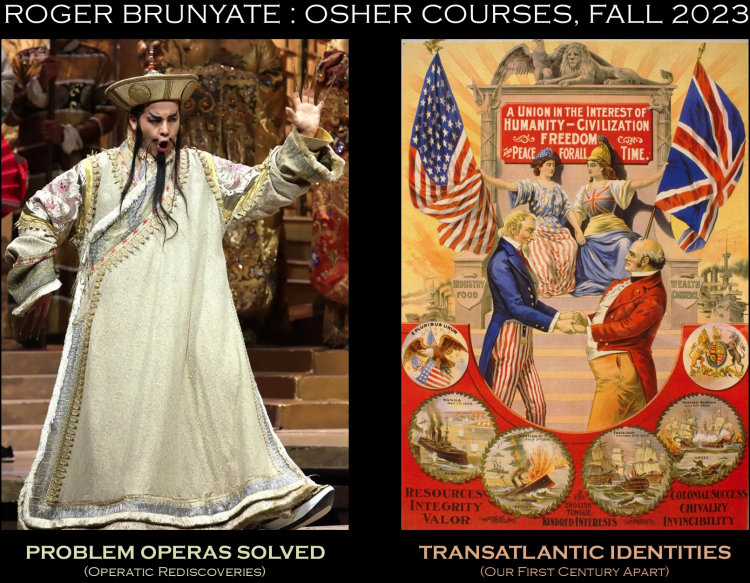
|
OSHER AT JHU : BRIGHTVIEW AT ROCKVILLE : THURSDAY AFTERNOONS, APRIL 13 TO MAY 11, 2023 | |

|
|
| Posters from the Royal Opera House, London | |
LINKS:
[1]
[2]
[3]
[4]
[5]
SYLLABUS (flat)
SYLLABUS (foldable)
Mozart's Magic Flute, Rossini's Barber of Seville, Verdi's La Traviata, Bizet's Carmen, and Puccini's La Bohème are five of the six most often performed operas in the world today (the sixth is Tosca, another Puccini). What makes them so popular, and so attractive to new opera-goers? And what can be done to keep them fresh for more experienced audiences? Is it the compelling quality of the stories, the emotional impact of the music, or the opportunity they give for brilliant spectacle and star singing? In the first hour of each class, I shall attempt to answer such questions by showing sample scenes from a traditional production.
But popularity also has its downsides. Excessive familiarity may make even a great work sound stale. Singers may find it hard to make each performance seem new when it is their fiftieth appearance in the role. Stage interpretations that have endeared themselves to older audience may not appeal to the younger generations whose support is essential if opera is to continue. So in the second hour, using my experience as a stage director myself, I will show newer approaches to the old classics, a different strategy in each case. Not all these productions will succeed, but all will provide plenty of material for discussion, that will reflect back upon the original in turn.
People who have taken my opera classes before will know that I have visited each of these operas in at least one other course before. But the focus this time will be different. While I may play some familiar scenes again, I will do so as much as possible from other productions and roam more widely in my search for alternate versions. Everything will be illustrated with high-quality videos with the English translations on the screen. I shall also send out synopses and other background materials in advance of each class. The RESOURCES link for each class will turn PINK when these become available; click it to get to the dedicated page for each class. rb.
| I am still working on this course. The dates and choice of operas will not change, but I may adjust some details as I prepare each class. In particular, the productions shown in the pictures below are representative and not necessarily the ones I will actually play. rb. |
| April 13 | |
 | |
| ROH London (above), Kenneth Branagh film (below) | HANDOUT FOLDED RESOURCES |
Mozart wrote The Magic Flute (1791) for a popular theater rather than the court, and it has always been a crowd-pleaser. It tells of a chivalric quest intertwined with magic both good and bad. Against this, we get the high ideals of a quasi-Masonic brotherhood, and the far-from-ideal tribulations of an ordinary man just trying to find his girl. Different productions have used the resources of the theater in different ways to find a balance between these elements, and there have even been a couple of films.
| April 20 | |
 | |
| Metropolitan Opera (above), San Francisco (below) | HANDOUT FOLDED RESOURCES |
Rossini’s Barber of Seville (1816) is surely the epitome of operatic farce. Though a failure at its first production (like two of the other operas here), its combination of romance and intrigue has won audiences ever since. In his attempt to get the attractive Rosina away from her jealous guardian, the young Count Almaviva enlists the help of the wily barber Figaro to get him into the house in two different disguises. Such a piece needs only careful rehearsal and skillful acting to keep it fresh, although designers continue to find stylish new ways to present it.
| April 27 | |
 | |
| Chicago (above), Metropolitan Opera (below) | HANDOUT FOLDED RESOURCES |
Verdi’s La Traviata (The Fallen Woman, 1853) was his only attempt to tackle a contemporary subject in a contemporary setting. Based on a Dumas play from just the year before, it tells of the Paris courtesan Violetta Valéry and her doomed attempt to break free of the demi-monde to pursue a true love. Though initially a failure like Barber and Carmen, it has since flourished the world over for the intensity of its emotion, the luxuriance of its setting, and not least as a showcase for its stars. While traditional productions have continued to deliver these qualities, the best new approaches strip away the excrescences to get back to a human truth that is always contemporary.
| May 4 | |
 | |
| ROH London (above), Barcelona (below) | HANDOUT FOLDED RESOURCES |
Bizet based his Carmen (1875) on a gritty novella by Prosper Mérimée about love, jealousy, and murder among the gypsies in Spain. A relative failure at its première, it only became the blockbuster we know today when its dialogue was replaced with sung recitative after the composer's death and its four separate settings were expanded into the grandest of grand-opera spectacles. More recent productions have restored the dialogue and brought it closer to the direct simplicity of Mérimée’s original, though some have taken this farther than others.
| May 11 | |
 | |
| Canadian Opera (above), Salzburg (below) | HANDOUT FOLDED RESOURCES |
Puccini’s La Bohème (The Bohemian Life, 1892), a simple story of young people living hand-to-mouth in Paris garrets, has inevitably become associated with the kind of lavish production exemplified by Franco Zeffirelli’s 40-year old spectacle at the Met. While this approach can still be energized by committed young-looking singers, probably no other opera has been subject to so many attempts (some of them quite radical) to restore its contemporary relevance.
Site hosted by DreamHost